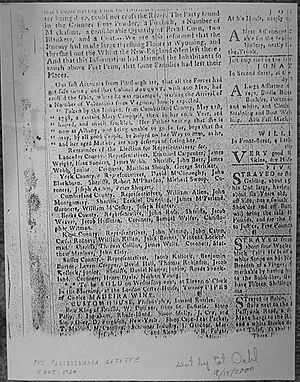Mary Campbell (colonial settler) facts for kids
Mary Campbell (later Mary Campbell Willford) was an early American settler. When she was a child, Native Americans captured her during the French and Indian War. After being rescued, she is thought to be the first white child to travel to the area known as the Western Reserve.
Contents
Mary Campbell's Early Life
Mary Campbell was born in 1747 or 1748. Her family was from a group called Scotch-Irish. This means they were people from Scotland who had lived in Ireland before moving to America.
Mary Campbell's Abduction Story
On May 21, 1758, when Mary was ten years old, she was taken from her home. This happened near a town called Penn's Creek in Pennsylvania. A group of Lenape (also known as the Delaware) Native Americans captured her.
Many people believe that Mary stayed with the tribe of a main Lenape chief named Netawatwees. He was also known by his English name, Newcomer. Local stories say this group brought her to a cave near the Cuyahoga River in what is now Cuyahoga Falls, Ohio. This cave is now called Mary Campbell Cave.
After a short time in the cave, she is said to have moved to a nearby Lenape village. This village might have been along the Cuyahoga River or on the flat land above the cave.
However, some family stories say Mary lived with the Lenape in a place called Newcomerstown in eastern Ohio. This place was named after Chief Netawatwees. It's likely that both stories are true. Chief Netawatwees and his people were near Cuyahoga Falls around 1758 or 1759. This was early in Mary's time as a captive. Later, he moved his group to eastern Ohio and started Newcomerstown.
It was common for Native American families to adopt captives. Mary was likely adopted into a Lenape family. She was certainly part of Chief Netawatwees's group, even if she wasn't adopted into his direct family.
Mary Campbell's Return Home
Mary Campbell returned to her family in Pennsylvania in 1764. This happened because of military pressure from British troops. Colonel Henry Bouquet led these troops. His forces won a key battle called the Battle of Bushy Run in August 1764. This battle was part of Pontiac's War, a conflict between Native Americans and the British.
After the battle, the British wanted the Native American tribes to return any white captives. On October 1, 1764, Colonel Bouquet met with Shawnee and Delaware leaders. The Native American leaders eventually agreed to give up their captives.
On October 3, Bouquet and 1,500 soldiers left Fort Pitt. They arrived at a place called Tuscarawas on October 13. Bouquet met with Native American leaders again. On October 20, he demanded that all captives be returned.
Mary Campbell was among the captives who were returned. Her name is on a list of 60 former captives. This list was made on November 15, 1764, at a camp near the Muskingum River in Ohio. Mary would have been 16 or 17 years old. She had spent about six and a half years with the Lenape. The captives arrived at Fort Pitt on November 28, 1764.
Some of Mary's descendants say she was sad to leave the Lenape. About half of the captives returned by Bouquet tried to go back to their Native American families. It's not known if Mary was one of them.
In October 1764, Mary Campbell's family placed an advertisement in the Pennsylvania Gazette newspaper. It asked for help in getting Mary home. The ad described her as "red haired, and much freckled." It also said her father heard she was in Albany and wanted her to be helped on her way home. This is the only known description of Mary from that time.
It's possible that one of Mary's brothers was with Colonel Bouquet's forces when she was returned. This would explain how her father knew where she was when he placed the advertisement.
Mary Campbell's Adult Life
Mary Campbell married Joseph Willford in 1770. This happened in Mt. Pleasant Township, Pennsylvania. They lived in different parts of Pennsylvania. Around 1782, they moved to Bald Ridge Farm in what is now Greene County, Pennsylvania.
Mary and Joseph Willford had seven children: five sons (Samuel, Daniel, William, Dougal, and Joseph) and two daughters (Elizabeth and Margaret). Mary Willford died in 1801, likely in Greene County, where she was buried.
Mary Campbell's Cultural Importance
Mary Campbell's story is well-known in Northeast Ohio and parts of Pennsylvania. She is seen as an example of bravery and strength. Her experience is often shared with children and taught in local schools.
Her story has inspired several books. These include Song of Courage, Song of Freedom: The Story of the Child, Mary Campbell, Held Captive in Ohio by the Delaware Indians from 1759–1764 by Marilyn Seguin. Another book is The Beaded Moccasins: The Story of Mary Campbell by Lynda Durrant. Both of these books are fictional stories based on her life.
Images for kids
-
Memorial to Mary Campbell, placed just outside Mary Campbell Cave.



